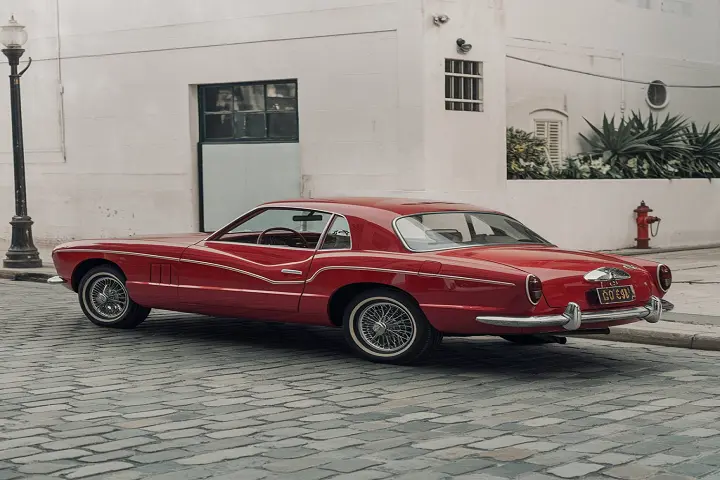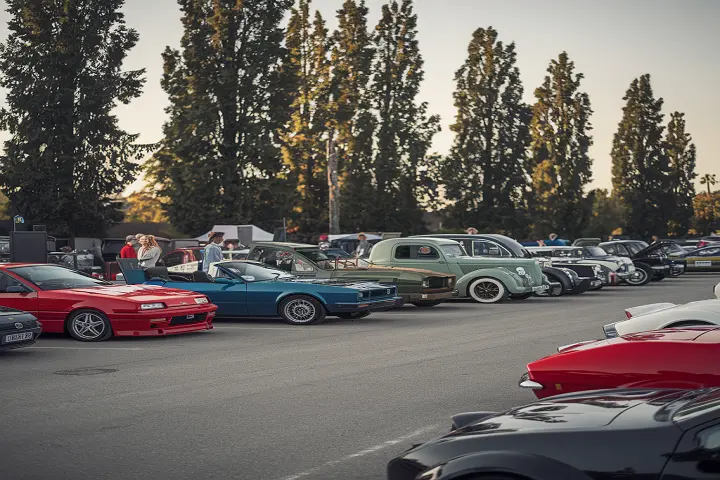In the grand tapestry of human innovation, few inventions have left as indelible a mark as the automobile. Cars, those four-wheeled marvels that have become an integral part of our daily lives, have transformed from mere horseless carriages to sophisticated, AI-driven machines.
They’ve shaped our cities, our culture and even our concept of freedom. Let’s buckle up and embark on a thrilling journey through the fascinating world of automobiles.
A Walk Through Automotive History
The story of the car begins in the late 19th century, a time of rapid technological advancement and boundless optimism.
While earlier attempts at self-propelled vehicles existed, it was Karl Benz’s 1885 Motorwagen that is often credited as the first true automobile.
This three-wheeled contraption, powered by a single-cylinder four-stroke engine, laid the foundation for the automotive revolution that would follow.
Revolutionary Models That Changed the Game
As the 20th century dawned, cars quickly evolved from novelties for the wealthy to essential tools for the masses. Several key models stand out as true game-changers:
- Ford Model T (1908): Henry Ford’s creation wasn’t the first car but it was the first to be mass-produced on an assembly line. This innovation drastically reduced costs, putting car ownership within reach of the American middle class.
- The Model T quite literally put America on wheels, selling over 15 million units during its production run.
- Volkswagen Beetle (1938): Designed under the Nazi regime as the “people’s car,” the Beetle went on to become a global phenomenon after World War II. Its distinctive shape and reliable, air-cooled engine made it a favorite around the world.
- The Beetle’s cultural impact extended far beyond transportation, becoming a symbol of the counterculture movement in the 1960s.
- Mini Cooper (1959): In response to the Suez Crisis and resulting fuel shortages, British Motor Corporation (BMC) tasked Alec Issigonis with creating a small, fuel-efficient car. The result was the Mini, a car that proved small could be both practical and stylish. Its transverse engine layout and front-wheel drive became a template for modern small cars.
- Toyota Prius (1997): As environmental concerns grew in the late 20th century, Toyota introduced the Prius, the first mass-produced hybrid electric vehicle. By combining a gasoline engine with an electric motor, the Prius offered significantly improved fuel efficiency. It paved the way for the hybrid and electric revolution we’re seeing today.
- Tesla Model S (2012): While not the first electric car, the Tesla Model S showed the world that electric vehicles could be luxurious, high-performance and desirable. Its success helped kick-start the current wave of electric vehicle development across the auto industry.
“The car has become an article of dress without which we feel uncertain, unclad and incomplete.” – Marshall McLuhan
This quote from media theorist Marshall McLuhan perfectly encapsulates how deeply cars have become ingrained in our society and self-image.
How Wars and Economic Shifts Shaped Car Design

The evolution of car design hasn’t happened in a vacuum. Global events and economic trends have profoundly influenced automotive development:
- World War I (1914-1918): The war effort led to advancements in mass production techniques and materials science, which later found their way into civilian automobile production.
- The Roaring Twenties: Economic prosperity in the 1920s fueled demand for more luxurious and powerful cars. This era saw the rise of brands like Duesenberg and Packard.
- The Great Depression (1929-1939): Economic hardship led to a focus on more affordable, practical vehicles. This period saw innovations in streamlining and aerodynamics to improve fuel efficiency.
- World War II (1939-1945): The war brought about significant advancements in manufacturing processes, synthetic materials, and engine technology. Post-war, these innovations were applied to civilian car production.
- Post-War Economic Boom: The 1950s and 60s in America saw a surge in car ownership. This period was characterized by larger cars with powerful engines, exemplified by the rise of muscle cars.
- 1970s Oil Crisis: Skyrocketing fuel prices led to a renewed focus on fuel efficiency. This era saw the rise of smaller cars and the beginning of Japanese automakers’ success in the US market.
- 1980s and 1990s Globalization: Increased global competition led to improvements in quality and reliability across the board. This period also saw the rise of the SUV as a popular vehicle category.
- 21st Century Environmental Concerns: Growing awareness of climate change has driven the development of hybrid and electric vehicles, as well as improvements in the efficiency of traditional combustion engines.
Each of these eras left its distinctive mark on automotive design, reflecting the needs, desires, and constraints of their times.
Under the Hood: The Nuts and Bolts
To truly appreciate cars, we need to understand what makes them tick. Let’s dive under the hood and explore the heart of these mechanical marvels.
Internal Combustion Engines: Still King of the Road?
For over a century, the internal combustion engine (ICE) has been the beating heart of most cars. Its basic principle remains unchanged: convert chemical energy from fuel into mechanical energy to drive the wheels. Here’s a quick look at how a four-stroke ICE works:
- Intake: The piston moves down, drawing a mixture of fuel and air into the cylinder.
- Compression: The piston moves up, compressing the fuel-air mixture.
- Combustion: The spark plug ignites the compressed mixture, driving the piston down.
- Exhaust: The piston moves up again, expelling the spent gases.
This cycle repeats thousands of times per minute, providing the power that propels our vehicles.
Despite its longevity, the ICE faces significant challenges in an increasingly eco-conscious world:
- Emissions: ICEs produce greenhouse gases and other pollutants, contributing to climate change and air pollution.
- Efficiency: Even the most advanced ICEs convert only about 20-35% of fuel energy into mechanical power, with the rest lost as heat.
- Dependence on fossil fuels: Most ICEs run on gasoline or diesel, non-renewable resources with volatile prices.
These challenges have spurred the development of alternative powertrains, particularly electric motors.
Electric Motors: The Silent Revolution
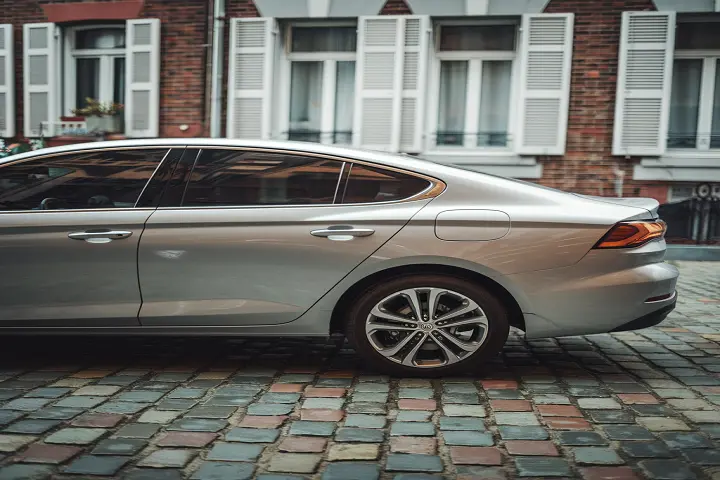
Electric cars are gaining ground fast, and for good reason. They offer several advantages over traditional ICEs:
- Instant torque: Electric motors deliver maximum torque from a standstill, providing quick acceleration.
- Simplified drivetrain: With fewer moving parts, electric powertrains are potentially more reliable and require less maintenance.
- Zero direct emissions: Electric cars produce no tailpipe emissions, making them cleaner in operation, especially when powered by renewable energy.
- Regenerative braking: Electric cars can recapture energy during braking, improving overall efficiency.
- Quieter operation: Electric motors are significantly quieter than ICEs, reducing noise pollution.
However, electric vehicles (EVs) still face some challenges:
- Range anxiety: While improving, many EVs still can’t match the range of gasoline-powered cars on a single charge.
- Charging time: Refueling an ICE vehicle takes minutes, while fully charging an EV can take hours.
- Battery production: The production of large batteries has its own environmental impacts, including mining of rare earth elements.
- Charging infrastructure: While growing, the network of charging stations is not yet as ubiquitous as gas stations.
Despite these challenges, many experts believe that electric cars represent the future of personal transportation.
Hybrid Systems: Best of Both Worlds
Hybrid cars aim to combine the best aspects of ICEs and electric motors. They typically use a gasoline engine alongside one or more electric motors. The most common types are:
- Parallel hybrids: Both the ICE and electric motor can drive the wheels directly.
- Series hybrids: The ICE acts as a generator to power the electric motor, which drives the wheels.
- Plug-in hybrids: These can be charged from an external power source and typically have a larger battery, allowing for extended electric-only operation.
Hybrids offer improved fuel efficiency without the range anxiety associated with pure electric vehicles. The Toyota Prius popularized this technology, paving the way for a wide range of hybrid vehicles across various manufacturers.
Design Philosophy: Where Form Meets Function
Car design is a delicate balance between aesthetics and practicality. Let’s explore some key aspects of automotive design philosophy.
Aerodynamics: More than Just Looking Sleek
While sleek, streamlined cars might look fast standing still, aerodynamics is about much more than aesthetics. Good aerodynamic design is crucial for:
- Reducing fuel consumption: Less air resistance means the engine doesn’t have to work as hard, improving efficiency.
- Improving high-speed stability: Proper airflow management helps keep the car planted at high speeds.
- Minimizing wind noise: Smooth airflow reduces turbulence, making for a quieter ride.
- Enhancing performance: In high-performance cars, aerodynamics can generate downforce, improving cornering ability.
The drag coefficient (Cd) is a key measure of a vehicle’s aerodynamic efficiency. The lower the Cd, the more aerodynamic the vehicle. Here’s how some popular cars stack up:
| Car Model | Drag Coefficient (Cd) |
| Tesla Model S | 0.208 |
| Mercedes-Benz EQS | 0.20 |
| Toyota Prius | 0.24 |
| Porsche 911 | 0.29 |
| Ford F-150 | 0.40 |
As you can see, electric vehicles like the Tesla Model S and Mercedes EQS tend to have very low drag coefficients, contributing to their extended range.
Sports cars like the Porsche 911 balance aerodynamics with other performance considerations, while larger vehicles like pickup trucks typically have higher drag due to their less streamlined shape.
Interior Ergonomics: Your Second Living Room
With Americans spending an average of about an hour per day in their cars, interior design has become increasingly important. Modern car interiors are designed with human factors (ergonomics) in mind. Key considerations include:
- Seat comfort: Seats need to provide support for long drives while accommodating a range of body types.
- Intuitive controls placement: Essential controls should be within easy reach and logically arranged.
- Visibility: The driver needs clear sightlines in all directions for safety.
- Noise, vibration, and harshness (NVH) reduction: A quiet, smooth ride reduces driver fatigue and enhances the overall experience.
- Climate control: Effective heating, cooling, and air filtration systems are crucial for comfort.
- Infotainment systems: Modern cars often feature large touchscreens for navigation, entertainment, and vehicle information.
- Storage: Thoughtful placement of cupholders, bins, and pockets can greatly enhance practicality.
Luxury car makers often go a step further, offering features like massage seats, ambient lighting, and high-end audio systems to create a truly premium environment.
The Psychology of Car Colors

The color of a car is more than just a personal preference. It can affect various aspects of ownership:
- Resale value: Neutral colors like silver, white, and black tend to hold their value better, as they appeal to a wider range of buyers.
- Safety: Lighter colors are more visible in low-light conditions, potentially reducing accident risk.
- Perceived temperature: Dark colors absorb more heat, which can affect comfort and fuel efficiency (due to increased A/C use) in hot climates.
- Perception: Colors can influence how a car is perceived. For example, red is often associated with sportiness, while silver is seen as modern and tech-savvy.
- Maintenance: Lighter colors tend to show dirt less, while darker colors can highlight scratches and swirl marks more.
Interestingly, global color preferences for cars tend to be quite conservative. According to a 2022 report by Axalta Coating Systems, the most popular car colors globally were:
- White (35%)
- Black (19%)
- Gray (19%)
- Silver (9%)
- Blue (8%)
These preferences can vary by region and vehicle type, but the dominance of neutral colors is a global trend.
The Tech Takeover
In recent years, technology has become an increasingly important aspect of car design and functionality. From entertainment systems to safety features, cars are becoming rolling computers.
Infotainment Systems: Beyond Radio and GPS
Modern infotainment systems have evolved far beyond simple radio and CD players. They’ve become the central hub for a car’s non-driving functions. Today’s systems offer:
- Touchscreen interfaces: Large, responsive screens for easy control of various functions.
- Voice commands: Allowing hands-free operation for safety and convenience.
- Smartphone integration: Systems like Apple CarPlay and Android Auto bring familiar interfaces into the car.
- Navigation: GPS systems with real-time traffic updates and points of interest.
- Vehicle diagnostics: Providing information about the car’s health and maintenance needs.
- Over-the-air updates: Allowing for continuous improvement and new features without visiting a dealership.
- Wi-Fi hotspots: Turning the car into a mobile internet hub.
- Customizable displays: Allowing users to prioritize the information most important to them.
These systems aim to make our time in the car more productive and enjoyable, but they also raise concerns about distracted driving. Manufacturers are constantly working to balance functionality with safety.
Advanced Driver-Assistance Systems (ADAS)
ADAS features are making cars safer and easier to drive. These systems use a combination of cameras, radar, and other sensors to monitor the vehicle’s surroundings and assist the driver. Common ADAS features include:
- Adaptive Cruise Control: Automatically adjusts speed to maintain a safe distance from the vehicle ahead.
- Lane Keeping Assist: Helps keep the car centered in its lane, often through gentle steering corrections.
- Automatic Emergency Braking: Applies the brakes if a collision is imminent and the driver doesn’t react in time.
- Blind Spot Monitoring: Alerts the driver to vehicles in their blind spots.
- Parking Assist: Helps with parallel and perpendicular parking, sometimes even parking the car automatically.
- Traffic Sign Recognition: Reads road signs and displays the information to the driver.
- Driver Attention Monitoring: Uses cameras or other sensors to detect signs of driver fatigue or distraction.
These systems are becoming increasingly common, even in non-luxury vehicles, as part of a broader push towards improved road safety.
The Road to Full Autonomy: Are We There Yet?
Self-driving cars have been a staple of science fiction for decades and they’re now becoming a reality. However, the road to full autonomy is long and complex. The Society of Automotive Engineers (SAE) defines six levels of driving automation:
- Level 0 (No Automation): The driver performs all driving tasks.
- Level 1 (Driver Assistance): The vehicle can assist with steering or acceleration/deceleration, but not both simultaneously. Example: Cruise control.
- Level 2 (Partial Automation): The vehicle can control both steering and acceleration/deceleration in some situations, but the driver must remain engaged. Example: Tesla Autopilot.
- Level 3 (Conditional Automation): The vehicle can handle all aspects of driving in some situations, but the driver must be ready to take control when prompted.
- Level 4 (High Automation): The vehicle can handle all driving tasks in specific circumstances without driver intervention.
- Level 5 (Full Automation): The vehicle can handle all driving tasks in all conditions, potentially without even having a steering wheel.
As of 2024, most advanced consumer cars are at Level 2, with some manufacturers pushing into Level 3. Companies like Waymo (owned by Alphabet/Google) are testing Level 4 systems in limited areas.
The promise of autonomous vehicles is compelling: improved safety, increased mobility for those who can’t drive, and more productive use of travel time. However, significant challenges remain, including:
- Technical challenges: Ensuring systems can handle all possible driving scenarios safely.
- Legal and ethical issues: Determining liability in accidents involving autonomous vehicles.
- Infrastructure needs: Potentially updating roads and signs to be more easily read by autonomous systems.
- Public acceptance: Convincing people to trust their lives to a computer.
While fully autonomous vehicles may still be years away for most consumers, the technology is advancing rapidly, and partially autonomous features are becoming increasingly common.
Performance Unleashed
Speed Demons: The Fastest Production Cars
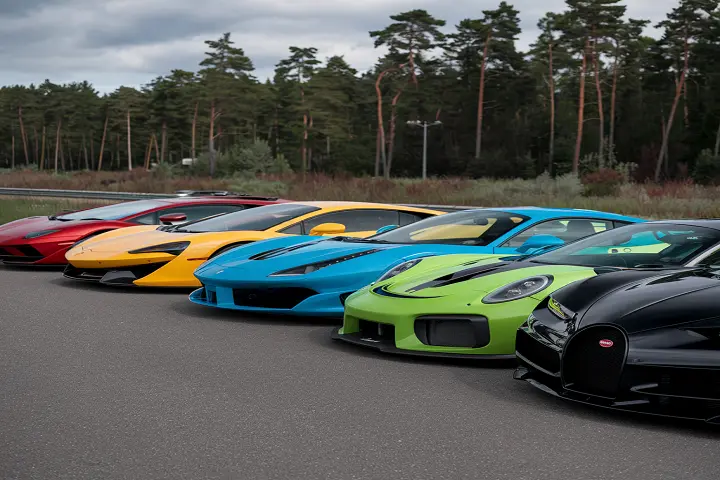
For some, nothing beats the thrill of pure speed. Here are some of the fastest production cars as of 2024:
- Bugatti Chiron Super Sport 300+: 304.77 mph
- Koenigsegg Jesko Absolut: 330 mph (theoretical)
- Hennessey Venom GT: 270.49 mph
- Bugatti Veyron Super Sport: 267.856 mph
- Bugatti Chiron: 261 mph
Off-road Warriors: Conquering the Untamed
Off-road vehicles are built to tackle the toughest terrains. Key features include:
- High ground clearance
- Four-wheel drive or all-wheel drive
- Rugged suspension systems
- Specialized tires
Popular off-road vehicles include the Jeep Wrangler, Toyota Land Cruiser, and Ford F-150 Raptor.
Eco-warriors: Pushing the Limits of Efficiency
As environmental concerns grow, so does the push for more efficient vehicles. Some standout eco-friendly cars include:
- Hyundai Ioniq Electric: 133 MPGe (miles per gallon equivalent)
- Tesla Model 3 Long Range: 134 MPGe
- Toyota Prius Prime: 133 MPGe in EV mode, 54 mpg in hybrid mode
The Environmental Equation
Emissions Regulations: A Global Perspective
Governments worldwide are tightening emissions regulations to combat climate change. Key regulations include:
- EU: Euro 6 standards, with plans for Euro 7
- US: Corporate Average Fuel Economy (CAFE) standards
- China: China 6 emissions standards
These regulations are pushing automakers towards cleaner technologies.
Alternative Fuels: Hydrogen, Biofuels, and Beyond
While electric cars are gaining popularity, other alternative fuels are also in development:
- Hydrogen fuel cells: Offer quick refueling and long range, but infrastructure is limited
- Biofuels: Made from renewable sources, can often be used in existing engines
- Synthetic fuels: Lab-created fuels that could be carbon-neutral
The Circular Economy: Recycling and Upcycling in the Auto Industry
Automakers are increasingly focusing on sustainability throughout a car’s lifecycle:
- Recycled materials in car interiors and bodies
- Battery recycling programs for electric vehicles
- Design for disassembly to make end-of-life recycling easier
The Future of Driving
Flying Cars: Science Fiction or Imminent Reality?
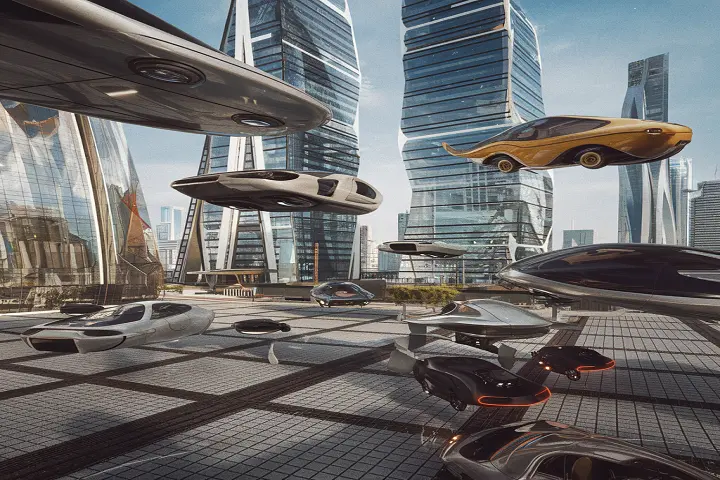
Several companies are working on flying cars, or more accurately, electric vertical takeoff and landing (eVTOL) vehicles. While we’re not quite in “The Jetsons” territory yet, progress is being made:
- Joby Aviation: Developing an air taxi service
- Terrafugia: Working on a roadable aircraft
- PAL-V: Offering a gyrocopter-car hybrid
Challenges include regulations, safety concerns, and infrastructure needs.
Sustainable Materials: From Bamboo to Recycled Ocean Plastic
Automakers are getting creative with sustainable materials:
- Ford: Using recycled plastic bottles in seat fabrics
- BMW: Incorporating recycled fishing nets in interior trim
- Volvo: Experimenting with bio-based materials for interior panels
The Sharing Economy: Will We Still Own Cars in 2050?
Car ownership models are evolving:
- Car-sharing services like Zipcar and Car2Go
- Ride-hailing apps like Uber and Lyft
- Subscription services offering flexibility between ownership and rental
These trends could reshape urban transportation and car ownership in the coming decades.
Maintaining Your Ride
DIY vs. Professional Maintenance: What You Can (and Shouldn’t) Do
While some maintenance tasks are DIY-friendly, others are best left to the professionals:
DIY-friendly tasks:
- Changing oil and filters
- Replacing windshield wipers
- Checking and maintaining tire pressure
Leave to the pros:
- Major engine work
- Transmission repairs
- Advanced electrical system diagnostics
The Truth About Extended Warranties
Extended warranties can provide peace of mind, but they’re not always necessary. Consider:
- Your car’s reliability rating
- How long you plan to keep the car
- Your comfort with unexpected repair costs
Read the fine print carefully before purchasing an extended warranty.
Keeping Your Classic Car Alive: A Labor of Love
Maintaining a classic car requires dedication:
- Regular use: Cars are meant to be driven
- Proper storage: Protect from elements when not in use
- Originality vs. modernization: Balance preserving history with usability
- Community: Connect with other enthusiasts for support and parts
The Culture of Cars
Car Clubs and Meetups: Finding Your Tribe

Car culture thrives on community. Whether you’re into muscle cars, imports, or EVs, there’s likely a club for you. Benefits include:
- Shared knowledge and expertise
- Group discounts on parts or services
- Organized events and drives
- A sense of belonging
Racing Subcultures: From F1 to Weekend Warriors
Motorsports come in many flavors:
- Formula 1: The pinnacle of technology and speed
- NASCAR: American stock car racing
- Rally: Off-road racing on public or private roads
- Drag racing: Straight-line speed contests
- Autocross: Timed competition through a defined course
Each has its own unique culture and fan base.
Cars in Pop Culture: Movies, Music, and More
Cars have left an indelible mark on popular culture:
- Movies: “Fast and Furious” franchise, “Back to the Future,” “Bullitt”
- TV shows: “Top Gear,” “Knight Rider,” “Pimp My Ride”
- Music: “Little Red Corvette” by Prince, “Drive My Car” by The Beatles
- Video games: “Gran Turismo,” “Forza,” “Need for Speed”
These portrayals both reflect and shape our relationship with cars.
Buying Smart: Navigate the Car Market Like a Pro
New vs. Used: Crunching the Numbers
The new vs. used debate involves more than just price:
New cars offer:
- Latest technology and safety features
- Full warranty coverage
- That new car smell
Used cars provide:
- Lower initial cost
- Less depreciation
- Potentially lower insurance rates
Consider your budget, needs, and how long you plan to keep the car.
Decoding Dealership Tactics
Be prepared when visiting a dealership:
- Research prices beforehand
- Understand the total cost of ownership, not just the sticker price
- Be willing to walk away if the deal isn’t right
- Get pre-approved financing to have leverage in negotiations
The Rise of Online Car Buying Platforms
Online platforms are changing car buying:
- Carvana: Offers a fully online experience with home delivery
- CarMax: Combines online shopping with physical locations
- TrueCar: Provides pricing information and connects with local dealers
These platforms often offer no-haggle pricing and return policies, reducing the stress of car buying.
Conclusion: The Road Ahead
As we look to the future, the relationship between humans and cars continues to evolve. From autonomous vehicles to flying cars, from sustainable materials to new ownership models, the automotive world is in a state of rapid change.
Yet, the core appeal of cars remains: the freedom to go where we want, when we want. As we prepare for the next automotive revolution, one thing is clear: our love affair with cars is far from over. It’s just entering an exciting new chapter.
Whether you’re a gearhead, an eco-warrior, or just someone who needs to get from A to B, the world of cars has something for you. So buckle up, keep your eyes on the road, and enjoy the ride into the automotive future!

With over 5 years of dedicated experience in the automotive industry, I am passionate about all things automotive. My journey began with a deep curiosity for automobiles, which led me to delve deeper into their mechanics, technology and trends. My expertise spans various aspects of the automotive world, from the latest electric vehicles to classic car restoration techniques. Through my articles, I aim to share my knowledge and insights, helping readers stay informed and inspired in the fast-paced world of the automobile.
